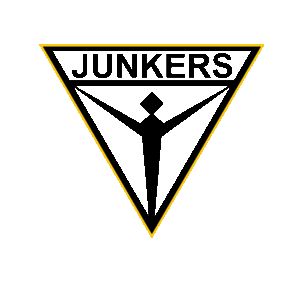
The Junkers Ju 87 or Stuka was a German dive bomber and ground-attack aircraft.
Designed by Hermann Pohlmann, it first flew in 1935.
The Ju 87 made its combat debut in 1937 with the Luftwaffe’s Condor Legion during the Spanish Civil War of 1936–1939 and served the Axis in World War II from beginning to end (1939–1945).
The aircraft is easily recognisable by its inverted gull wings and fixed spatted undercarriage.
Upon the leading edges of its faired main gear legs were mounted ram-air sirens known as Jericho trumpets, which became a propaganda symbol of German air power and of the so-called Blitzkrieg victories of 1939–1942, as well as providing Stuka pilots with audible feedback as to speed.
The Stuka’s design included several innovations, including automatic pull-up dive brakes under both wings to ensure that the aircraft recovered from its attack dive even if the pilot blacked out from the high g-forces.
The Ju 87 operated with considerable success in close air support and anti-shipping roles at the outbreak of World War II.
It led air assaults in the invasion of Poland in September 1939.
Stukas proved critical to the rapid conquest of Norway, the Netherlands, Belgium and France in 1940.
Though sturdy, accurate, and very effective against ground targets, the Stuka was, like many other dive bombers of the period, vulnerable to fighter aircraft.
During the Battle of Britain of 1940-1941, its lack of manoeuvrability, speed and defensive armament meant that it required a heavy fighter escort to operate effectively.
After the Battle of Britain, the Luftwaffe deployed Stuka units in the Balkans Campaign, the African and the Mediterranean theatres and in the early stages of the Eastern Front war, where it was used for general ground support, as an effective specialised anti-tank aircraft and in an anti-shipping role.
Once the Luftwaffe lost air superiority, the Stuka became an easy target for enemy fighters, but it continued being produced until 1944 for lack of a better replacement.
By 1945 ground-attack versions of the Focke-Wulf Fw 190 had largely replaced the Ju 87, but it remained in service until the end of the war in 1945.
Germany built an estimated 6,000 Ju 87s of all versions between 1936 and August 1944.
Oberst Hans-Ulrich Rudel became the most successful Stuka pilot and the most highly decorated German pilot of the war.
The Ju 87 was a single-engined all-metal cantilever monoplane.
It had a fixed undercarriage and could carry a two-person crew.
The main construction material was duralumin, and the external coverings were made of duralumin sheeting.
Parts that were required to be of strong construction, such as the wing flaps, were made of Pantal (a German aluminium alloy containing titanium as a hardening element) and its components made of Elektron.
Bolts and parts that were required to take heavy stress were made of steel.
The Ju 87 was fitted with detachable hatches and removable coverings to aid and ease maintenance and overhaul.
The designers avoided welding parts wherever possible, preferring moulded and cast parts instead.
Large airframe segments were interchangeable as a complete unit, which increased speed of repair.
The airframe was also subdivided into sections to allow transport by road or rail.
The wings were of standard Junkers double-wing construction.
This gave the Ju 87 considerable advantage on take-off; even at a shallow angle, large lift forces were created through the aerofoil, reducing take-off and landing runs.
In accordance with the Aircraft Certification Centre for “Stress Group 5”, the Ju 87 had reached the acceptable structural strength requirements for a dive bomber.
It was able to withstand diving speeds of 600 km/h (370 mph) and a maximum level speed of 340 km/h (210 mph) near ground level, and a flying weight of 4,300 kg (9,500 lb).
Performance in the diving attack was enhanced by the introduction of dive brakes under each wing, which allowed the Ju 87 to maintain a constant speed and allow the pilot to steady his aim.
It also prevented the crew from suffering extreme g forces and high acceleration during “pull-out” from the dive.
The fuselage had an oval cross-section and housed, in most examples, a Junkers Jumo 211 water-cooled inverted V-12 engine.
The cockpit was protected from the engine by a firewall ahead of the wing centre section where the fuel tanks were located.
At the rear of the cockpit, the bulkhead was covered by a canvas cover which could be breached by the crew in an emergency, enabling them to escape into the main fuselage.
The canopy was split into two sections and joined by a strong welded steel frame.
The canopy itself was made of Plexiglas and each compartment had its own “sliding hood” for the two crew members.
The engine was mounted on two main support frames that were supported by two tubular struts.
The frame structure was triangulated and emanated from the fuselage.
The main frames were bolted onto the engine’s top quarter.
In turn, the frames were attached to the firewall by universal joints.
The firewall itself was constructed from asbestos mesh with dural sheets on both sides.
All conduits passing through had to be arranged so that no harmful gases could penetrate the cockpit.
The fuel system comprised two fuel tanks between the main (forward) and rear spars of the (inner) anhedral wing section of the port and starboard wings, each with 240-litre (63 US gal) capacity.
The tanks also had a predetermined limit which, if passed, would warn the pilot via a red warning light in the cockpit.
The fuel was injected via a pump from the tanks to the engine.
Should this shut down, it could be pumped manually using a hand-pump on the fuel cock armature.
The powerplant was cooled by a 10-litre (2.6 US gal), ring-shaped aluminium water container situated between the propeller and engine.
A further container of 20-litre (5.3 US gal) was positioned under the engine.
The control surfaces operated in much the same way as other aircraft, with the exception of the innovative automatic pull-out system.
Releasing the bomb initiated the pull-out, or automatic recovery and climb, upon the deflection of the dive brakes.
The pilot could override the system by exerting significant force on the control column and taking manual control.
The wing was the most unusual feature.
It consisted of a single centre section and two outer sections installed using four universal joints.
The centre section had a large negative dihedral (anhedral) and the outer surfaces a positive dihedral.
This created the inverted gull, or “cranked”, wing pattern along the leading edge.
The shape of the wing improved the pilot’s ground visibility and also allowed a shorter undercarriage height.
The centre section protruded by only 3 m (9 ft 10 in) on either side.
The offensive armament was two 7.92 mm (.312 in) MG 17 machine guns fitted one in each wing outboard of undercarriage, operated by a mechanical pneumatics system from the pilot’s control column.
The rear gunner/radio operator operated one 7.92 mm (.312 in) MG 15 machine gun for defensive purposes.
The engine and propeller had automatic controls, and an auto-trimmer made the aircraft tail-heavy as the pilot rolled over into his dive, lining up red lines at 60°, 75° or 80° on the cockpit side window with the horizon and aiming at the target with the sight of the fixed gun.
The heavy bomb was swung down clear of the propeller on crutches prior to release.
Variants
Prototypes
Ju 87 V1.
Flown on 17 September 1935
Ju 87 V2.
Registration D-IDQR.
Flown on 25 February 1936.
Flown again as registration D-UHUH on 4 June 1937
Ju 87 V3.
Flown on 27 March 1936
Ju 87 V4.
Flown on 20 June 1936
Ju 87 V5
Flown on 14 August 1936
Production variants
Ju 87 A-0
Ten pre-production aircraft, powered by a 640 PS (471 kW or 632 hp) Jumo 210C engine.
Ju 87 A-1
Initial production version.
Ju 87 A-2
Production version fitted with an improved 680 PS (500 kW or 670 hp) Jumo 210E engine.
Ju 87 V6.
Flown on 14 June 1937 (A-0 to B-0 conversion)
Ju 87 V7.
Prototype of the Ju 87B, powered by a 1,000 PS (735 kW or 986 hp) Jumo 211A.
Flown on 23 August 1937 (A-0 to B-0 conversion)
Ju 87 V8.
Flown on 11 November 1937
Ju 87 V9.
Flown on 16 February 1938 as D-IELZ.
Flown again as WL-IELZ on 16 October 1939
Ju 87 V10
Registration D-IHFH (changed to Stammkennzeichen of TK+HD).
First flown 17 March 1938
Ju 87 V11 Stammkennzeichen.
First flown 12 May 1938
Ju 87 V15.
Destroyed in a crash in 1942.
Ju 87 V16 Stammkennzeichen.
Ju 87 V17 and Ju 87 V18 may never have been built.
Ju 87 V 21.
Airframe conversion from B-1 to D-1.
First flown on 1 March 1941.
Ju 87 V 22 Stammkennzeichen.
Also, airframe conversion from B-1 to D-1.
First flown on 1 March 1941.
Ju 87 V 23 Stammkennzeichen.
Also, airframe conversion from B-1 to D-1.
First flown on 1 March 1941.
Ju 87 V 24 Stammkennzeichen.
Also, airframe conversion from B-1 to D-1/D-4.
First flown on 1 March 1941.
Ju 87 V 25 Stammkennzeichen.
Also, airframe conversion from B-1 to D-4 trop.
First flown on 1 March 1941.
Ju 87 V 30
The only known prototype of the Ju 87 D-5.
First flown on 20 June 1943.
Ju 87 V 26-28, Ju 87 V 31, and V 42-47 were experiments of unknown variants.
Specifications
Ju 87B-1
Crew
2
Length
11.10 m (36 ft 5 in)
Wingspan
13.805 m (45 ft 3.5 in)
Height
4.01 m (13 ft 2 in)
Wing area
31.900 m2 (343.37 sq ft)
Airfoil
Göttingen 256
Empty weight
2,712 kg (5,980 lb)
Empty equipped weight
2,760 kg (6,090 lb)
Max take-off weight
4,336 kg (9,560 lb)
Powerplant
1 × Junkers Jumo 211Da,
V-12 inverted liquid-cooled piston engine,
890 kW (1,200 hp) for take-off
820 kW (1,100 hp) at 1,500 m (4,920 ft)
Propellers
3-bladed Junkers constant-speed propeller
Performance
Maximum speed
339.6 km/h (211.0 mph, 183.4 kn) at sea level
383 km/h (238 mph; 207 kn) at 4,087 m (13,410 ft)
Cruise speed
209 km/h (130 mph, 113 kn) at 4,572 m (15,000 ft)
Range
595.5 km (370.0 mi, 321.5 nmi) with 500 kg (1,102 lb) bomb
789 km (490 mi; 426 nmi) without bomb load
Rate of climb
2.3 m/s (450 ft/min)
Time to altitude
1,000 m (3,281 ft) in 2 minutes
2,000 m (6,562 ft) in 4 minutes 18 seconds
3,716 m (12,190 ft) in 12 minutes
Armament
Guns
2× 7.92 mm (0.312 in) MG 17 machine gun forward,
1× 7.92 mm (0.312 in) MG 15 machine gun to rear
Bombs
1× 250 kg (550 lb) bomb beneath the fuselage
&
4× 50 kg (110 lb) under-wing.


